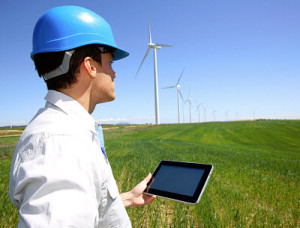Technological advancements in wind energy is good news for North Carolina
January 5, 2015Southeastern North Carolina may become a suitable location for wind farms.
According to energy officials, wind energy technology advancements, which have resulted in wind turbines generating more power with less resources, has made areas like southeastern North Carolina more appropriate for wind farms.
Towers for turbines are increasing in height and rotor blades are being designed longer.
Changes that have been made over the past decade have advanced wind turbines, making them more effective energy producers. According to the technology deployment manager for the U.S. Department of Energy’s National Renewable Energy Laboratory, Ian Baring-Gould, “turbines are getting more efficient over time.” He added that “we certainly see this continuing in the future.” He explained that towers that hold wind turbines are becoming taller and the rotor blades longer, which improves their efficiency.
These advancements make it possible for regions in North Carolina that are typically more favorable for solar energy to have greater potential for wind farms.
Technological advances are opening up more wind energy options for the state.
 In an online presentation that was hosted by the Southeastern Wind Coalition, Baring-Gould said that back in 2008, the land in North Carolina that was best suited to wind development was primarily in the mountains. However, the development of wind farms along the coast has become a possibility due to recent changes, and that region is anticipated to expand in the next five to ten years.
In an online presentation that was hosted by the Southeastern Wind Coalition, Baring-Gould said that back in 2008, the land in North Carolina that was best suited to wind development was primarily in the mountains. However, the development of wind farms along the coast has become a possibility due to recent changes, and that region is anticipated to expand in the next five to ten years.
That being said, the president of the Southeastern Wind Coalition, Brian O’Hara, said that the expansion does not mean that these areas will be developed for wind power. O’Hara said that the northeastern part of the state is currently more suitable for wind farms than the southeastern part. Nonetheless, he also stated that “Technological advances are opening up more options.”
According to Baring-Gould, even when the amount of wind has not changed in a region, wind energy development can increase. He said that “It’s all about how the technology is able to use the wind resource that is present in a given area.”
He explained that, in the past, the southeastern part of the United States was considered impractical for wind farms, but with wind energy technology changing, the viability for wind farms in those areas could change in the future.

 HFN News is your leading source for fresh hydrogen and renewable energy updates. Amid the fast-paced growth of hydrogen companies, we provide top-notch news and insights about this exciting sector. Our coverage spans from hydrogen cars to global sustainable initiatives, and we highlight the latest in green jobs and developing hydrogen hubs. We invite you to share your local hydrogen news and explore today’s renewable energy job listings on our site. Thanks for choosing HFN News as your trusted guide to the hydrogen and renewable energy world!
HFN News is your leading source for fresh hydrogen and renewable energy updates. Amid the fast-paced growth of hydrogen companies, we provide top-notch news and insights about this exciting sector. Our coverage spans from hydrogen cars to global sustainable initiatives, and we highlight the latest in green jobs and developing hydrogen hubs. We invite you to share your local hydrogen news and explore today’s renewable energy job listings on our site. Thanks for choosing HFN News as your trusted guide to the hydrogen and renewable energy world!